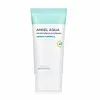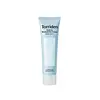What's inside
What's inside
 Key Ingredients
Key Ingredients

 Benefits
Benefits

 Concerns
Concerns

No concerns
 Ingredients Side-by-side
Ingredients Side-by-side

Water
Skin ConditioningAlcohol Denat.
AntimicrobialEthylhexyl Methoxycinnamate
UV AbsorberEthylhexyl Salicylate
UV AbsorberC12-15 Alkyl Benzoate
AntimicrobialDipropylene Glycol
HumectantPhenylbenzimidazole Sulfonic Acid
UV AbsorberTitanium Dioxide
Cosmetic ColorantPolyglyceryl-3 Methylglucose Distearate
EmulsifyingBis-Ethylhexyloxyphenol Methoxyphenyl Triazine
Skin ConditioningTromethamine
BufferingDiethylamino Hydroxybenzoyl Hexyl Benzoate
UV FilterDimethicone
EmollientPanthenol
Skin ConditioningGlyceryl Stearate
EmollientPEG-100 Stearate
Polyacrylate Crosspolymer-6
Emulsion StabilisingXanthan Gum
EmulsifyingHydrolyzed Hyaluronic Acid
HumectantSodium Hyaluronate
HumectantGlycerin
HumectantButylene Glycol
Humectant1,2-Hexanediol
Skin ConditioningMadecassoside
AntioxidantArtemisia Annua Extract
MaskingAzadirachta Indica Leaf Extract
Skin ConditioningCamellia Sinensis Leaf Extract
AntimicrobialAnthriscus Sylvestris Extract
Skin ConditioningVitis Vinifera Vine Sap
Skin ConditioningBambusa Arundinacea Juice
AbrasiveBetula Platyphylla Japonica Juice
Skin ConditioningTrichosanthes Kirilowii Root Extract
Skin ProtectingAluminum Stearate
Cosmetic ColorantPolyhydroxystearic Acid
EmulsifyingAlumina
AbrasiveTrisodium EDTA
T-Butyl Alcohol
PerfumingParfum
MaskingLimonene
PerfumingLinalool
PerfumingCitral
PerfumingCitronellol
PerfumingGeraniol
PerfumingWater, Alcohol Denat., Ethylhexyl Methoxycinnamate, Ethylhexyl Salicylate, C12-15 Alkyl Benzoate, Dipropylene Glycol, Phenylbenzimidazole Sulfonic Acid, Titanium Dioxide, Polyglyceryl-3 Methylglucose Distearate, Bis-Ethylhexyloxyphenol Methoxyphenyl Triazine, Tromethamine, Diethylamino Hydroxybenzoyl Hexyl Benzoate, Dimethicone, Panthenol, Glyceryl Stearate, PEG-100 Stearate, Polyacrylate Crosspolymer-6, Xanthan Gum, Hydrolyzed Hyaluronic Acid, Sodium Hyaluronate, Glycerin, Butylene Glycol, 1,2-Hexanediol, Madecassoside, Artemisia Annua Extract, Azadirachta Indica Leaf Extract, Camellia Sinensis Leaf Extract, Anthriscus Sylvestris Extract, Vitis Vinifera Vine Sap, Bambusa Arundinacea Juice, Betula Platyphylla Japonica Juice, Trichosanthes Kirilowii Root Extract, Aluminum Stearate, Polyhydroxystearic Acid, Alumina, Trisodium EDTA, T-Butyl Alcohol, Parfum, Limonene, Linalool, Citral, Citronellol, Geraniol
Water
Skin ConditioningPropanediol
SolventDibutyl Adipate
EmollientBis-Ethylhexyloxyphenol Methoxyphenyl Triazine
Skin ConditioningDiethylamino Hydroxybenzoyl Hexyl Benzoate
UV FilterEthylhexyl Triazone
UV AbsorberPolymethylsilsesquioxane
Polysilicone-15
UV FilterDiisopropyl Adipate
EmollientNiacinamide
SmoothingMethylene Bis-Benzotriazolyl Tetramethylbutylphenol
UV FilterMethyl Methacrylate Crosspolymer
Hydroxyethyl Urea
Humectant1,2-Hexanediol
Skin ConditioningPentylene Glycol
Skin ConditioningPolyglyceryl-3 Methylglucose Distearate
EmulsifyingBehenyl Alcohol
EmollientAcrylates/C10-30 Alkyl Acrylate Crosspolymer
Emulsion StabilisingPanthenol
Skin ConditioningTromethamine
BufferingHydroxyacetophenone
AntioxidantPoly C10-30 Alkyl Acrylate
Emulsion StabilisingSodium Acrylates Crosspolymer-2
AbsorbentDipotassium Glycyrrhizate
HumectantDecyl Glucoside
CleansingSodium Stearoyl Glutamate
CleansingEclipta Prostrata Extract
Skin ConditioningMelia Azadirachta Leaf Extract
Skin ConditioningAllantoin
Skin ConditioningPolyacrylate Crosspolymer-6
Emulsion StabilisingAdenosine
Skin ConditioningMelia Azadirachta Flower Extract
Skin ConditioningCoccinia Indica Fruit Extract
Skin ConditioningGlycerin
HumectantBiosaccharide Gum-1
HumectantXanthan Gum
EmulsifyingAloe Barbadensis Flower Extract
EmollientSolanum Melongena Fruit Extract
Skin ConditioningMoringa Oleifera Seed Oil
EmollientSimmondsia Chinensis Seed Oil
EmollientCorallina Officinalis Extract
Skin ConditioningCurcuma Longa Root Extract
MaskingOcimum Sanctum Leaf Extract
Skin ConditioningButylene Glycol
HumectantDimethylsilanol Hyaluronate
HumectantHydrolyzed Hyaluronic Acid
HumectantHydrolyzed Sodium Hyaluronate
Skin ConditioningHyaluronic Acid
HumectantPotassium Hyaluronate
Skin ConditioningSodium Hyaluronate
HumectantHydroxypropyltrimonium Hyaluronate
Sodium Hyaluronate Crosspolymer
HumectantSodium Hyaluronate Dimethylsilanol
HumectantSodium Acetylated Hyaluronate
HumectantMalachite Extract
AntioxidantWater, Propanediol, Dibutyl Adipate, Bis-Ethylhexyloxyphenol Methoxyphenyl Triazine, Diethylamino Hydroxybenzoyl Hexyl Benzoate, Ethylhexyl Triazone, Polymethylsilsesquioxane, Polysilicone-15, Diisopropyl Adipate, Niacinamide, Methylene Bis-Benzotriazolyl Tetramethylbutylphenol, Methyl Methacrylate Crosspolymer, Hydroxyethyl Urea, 1,2-Hexanediol, Pentylene Glycol, Polyglyceryl-3 Methylglucose Distearate, Behenyl Alcohol, Acrylates/C10-30 Alkyl Acrylate Crosspolymer, Panthenol, Tromethamine, Hydroxyacetophenone, Poly C10-30 Alkyl Acrylate, Sodium Acrylates Crosspolymer-2, Dipotassium Glycyrrhizate, Decyl Glucoside, Sodium Stearoyl Glutamate, Eclipta Prostrata Extract, Melia Azadirachta Leaf Extract, Allantoin, Polyacrylate Crosspolymer-6, Adenosine, Melia Azadirachta Flower Extract, Coccinia Indica Fruit Extract, Glycerin, Biosaccharide Gum-1, Xanthan Gum, Aloe Barbadensis Flower Extract, Solanum Melongena Fruit Extract, Moringa Oleifera Seed Oil, Simmondsia Chinensis Seed Oil, Corallina Officinalis Extract, Curcuma Longa Root Extract, Ocimum Sanctum Leaf Extract, Butylene Glycol, Dimethylsilanol Hyaluronate, Hydrolyzed Hyaluronic Acid, Hydrolyzed Sodium Hyaluronate, Hyaluronic Acid, Potassium Hyaluronate, Sodium Hyaluronate, Hydroxypropyltrimonium Hyaluronate, Sodium Hyaluronate Crosspolymer, Sodium Hyaluronate Dimethylsilanol, Sodium Acetylated Hyaluronate, Malachite Extract
 Reviews
Reviews

Ingredients Explained
These ingredients are found in both products.
Ingredients higher up in an ingredient list are typically present in a larger amount.
1,2-Hexanediol is a synthetic liquid and another multi-functional powerhouse.
It is a:
- Humectant, drawing moisture into the skin
- Emollient, helping to soften skin
- Solvent, dispersing and stabilizing formulas
- Preservative booster, enhancing the antimicrobial activity of other preservatives
You might know this ingredient as Tinosorb S or Bemotrizinol. It is a UV filter that covers both UVA and UVB rays.
This ingredient has two peak UV absorption peaks ( 310 and 340 nm) and is able to absorb both UV-A and UV-B rays. This ingredient works by preventing UV rays from reaching and damaging your skin.
On top of that - it is highly photostable and helps prevent the photodegration of other sunscreen ingredients such as avobenzone.
Tinosorb S is allowed in the EU, Australia, and Asia. It is close to being approved by the FDA and we'll hopefully get this ingredient in the U.S. by late 2025.
Fun fact: Tinosorb S is the most effective UV absorber at maximum concentration (measured by SPF) permitted in the EU.
This ingredient is oil-soluble, so your oil-cleansers will take this right off at night.
Learn more about Bis-Ethylhexyloxyphenol Methoxyphenyl TriazineButylene Glycol (or BG) is used within cosmetic products for a few different reasons:
Overall, Butylene Glycol is a safe and well-rounded ingredient that works well with other ingredients.
Though this ingredient works well with most skin types, some people with sensitive skin may experience a reaction such as allergic rashes, closed comedones, or itchiness.
Learn more about Butylene GlycolDiethylamino Hydroxybenzoyl Hexyl Benzoate (DHHB) is a chemical UV-A absorber. It is formulated for high UVA protection (320-400 nm).
DHHB is well-liked for:
DHHB has been approved by the EU, Japan, Taiwan, and South America for use up to 10%. Unfortunately, it has not been approved for use in the US or Canada due to slow regulatory processes.
This ingredient is soluble in oils, fats, and lipids.
Learn more about Diethylamino Hydroxybenzoyl Hexyl BenzoateGlycerin is already naturally found in your skin. It helps moisturize and protect your skin.
A study from 2016 found glycerin to be more effective as a humectant than AHAs and hyaluronic acid.
As a humectant, it helps the skin stay hydrated by pulling moisture to your skin. The low molecular weight of glycerin allows it to pull moisture into the deeper layers of your skin.
Hydrated skin improves your skin barrier; Your skin barrier helps protect against irritants and bacteria.
Glycerin has also been found to have antimicrobial and antiviral properties. Due to these properties, glycerin is often used in wound and burn treatments.
In cosmetics, glycerin is usually derived from plants such as soybean or palm. However, it can also be sourced from animals, such as tallow or animal fat.
This ingredient is organic, colorless, odorless, and non-toxic.
Glycerin is the name for this ingredient in American English. British English uses Glycerol/Glycerine.
Learn more about GlycerinHydrolyzed Hyaluronic Acid is a form of hyaluronic acid. It is created by the hydrolysis of hyaluronic acid with a high molecular weight. Once created, Hydrolyzed Hyaluronic Acid has a low molecular weight.
Low molecular weight HA has been shown to hydrate and increase elasticity of the skin. Increasing elasticity is also associated with reduction of wrinkle depth.
One study found topical low molecular weight hyaluronic acid may be considered for the treatment of rosacea in the adult population. However, we always recommend speaking with a professional about your skin concerns.
Hyaluronic acids are a humectant. This means they draw moisture from the air. Hyaluronic acids help moisturize, soothe, and protect the skin.
Read more about other common forms of hyaluronic acid:
Learn more about Hydrolyzed Hyaluronic AcidPanthenol is a common ingredient that helps hydrate and soothe the skin. It is found naturally in our skin and hair.
There are two forms of panthenol: D and L.
D-panthenol is also known as dexpanthenol. Most cosmetics use dexpanthenol or a mixture of D and L-panthenol.
Panthenol is famous due to its ability to go deeper into the skin's layers. Using this ingredient has numerous pros (and no cons):
Like hyaluronic acid, panthenol is a humectant. Humectants are able to bind and hold large amounts of water to keep skin hydrated.
This ingredient works well for wound healing. It works by increasing tissue in the wound and helps close open wounds.
Once oxidized, panthenol converts to pantothenic acid. Panthothenic acid is found in all living cells.
This ingredient is also referred to as pro-vitamin B5.
Learn more about PanthenolPolyacrylate Crosspolymer-6 is a texture enhancer and pH adjuster.
It is be used to thicken water-based products and create a gel-texture with a velvet feel.
One manufacturer claims this ingredient to have a pH range of 2-8 and to be biodegradable.
Learn more about Polyacrylate Crosspolymer-6Polyglyceryl-3 Methylglucose Distearate is created from the diester of stearic acid and the condensation product of methylglucose and Polyglycerin-3.
As an emulsifier, it is used to bind ingredients together. Many ingredients, such as oils and water, separate naturally. Emulsifiers prevent them from separating to ensure even consistency in texture.
One of the manufacturer for this ingredient states it is vegetable-based. It is also claimed to be stable at both high and low temperatures.
This ingredient may not be safe for fungal acne. We recommend speaking with a professional if you have any concerns.
Learn more about Polyglyceryl-3 Methylglucose DistearateSodium Hyaluronate is hyaluronic acid's salt form. It is commonly derived from the sodium salt of hyaluronic acid.
Like hyaluronic acid, it is great at holding water and acts as a humectant. This makes it a great skin hydrating ingredient.
Sodium Hyaluronate is naturally occurring in our bodies and is mostly found in eye fluid and joints.
These are some other common types of Hyaluronic Acid:
Learn more about Sodium HyaluronateTromethamine helps balance the pH and improve the texture of a product. It is synthetically created.
As an emulsifier, Tromethamine prevents oil and water ingredients from separating. This helps stabilize the product and elongate a product's shelf life. Tromethamine also makes a product thicker.
Tromethamine helps balance the pH level of a product. Normal pH level of skin is slightly acidic (~4.75-5.5). The acidity of our skin is maintained by our glands and skin biome. Being slightly acidic allows our skin to create an "acid mantle". This acid mantle is a thin barrier that protects our skin from bacteria and contaminants.
Oral Tromethanmine is an anti-inflammatory drug but plays the role of masking, adding fragrance, and/or balancing pH in skincare.
1,3-Propanediol, 2-amino-2-(hydroxymethyl)-
Learn more about TromethamineWater. It's the most common cosmetic ingredient of all. You'll usually see it at the top of ingredient lists, meaning that it makes up the largest part of the product.
So why is it so popular? Water most often acts as a solvent - this means that it helps dissolve other ingredients into the formulation.
You'll also recognize water as that liquid we all need to stay alive. If you see this, drink a glass of water. Stay hydrated!
Learn more about WaterXanthan gum is used as a stabilizer and thickener within cosmetic products. It helps give products a sticky, thick feeling - preventing them from being too runny.
On the technical side of things, xanthan gum is a polysaccharide - a combination consisting of multiple sugar molecules bonded together.
Xanthan gum is a pretty common and great ingredient. It is a natural, non-toxic, non-irritating ingredient that is also commonly used in food products.
Learn more about Xanthan Gum